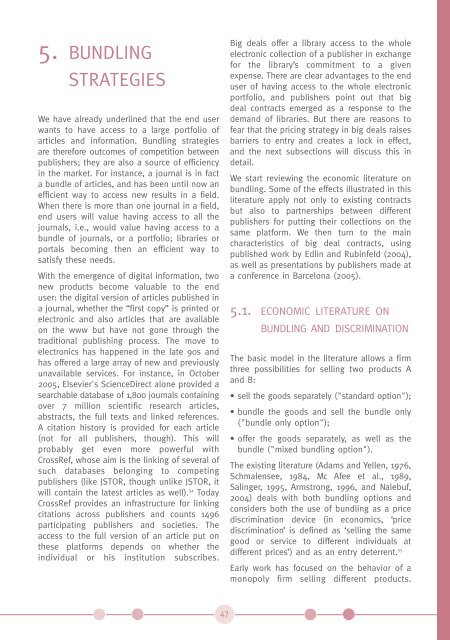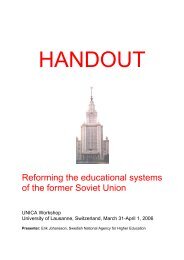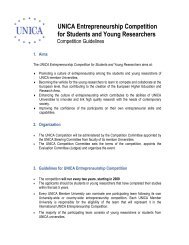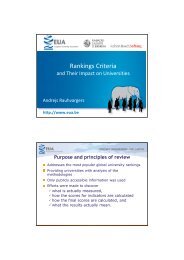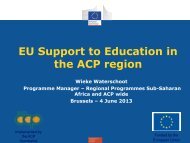Study on the economic and technical evolution of the scientific ...
Study on the economic and technical evolution of the scientific ...
Study on the economic and technical evolution of the scientific ...
Create successful ePaper yourself
Turn your PDF publications into a flip-book with our unique Google optimized e-Paper software.
5. BUNDLING<br />
STRATEGIES<br />
We have already underlined that <strong>the</strong> end user<br />
wants to have access to a large portfolio <strong>of</strong><br />
articles <strong>and</strong> informati<strong>on</strong>. Bundling strategies<br />
are <strong>the</strong>refore outcomes <strong>of</strong> competiti<strong>on</strong> between<br />
publishers; <strong>the</strong>y are also a source <strong>of</strong> efficiency<br />
in <strong>the</strong> market. For instance, a journal is in fact<br />
a bundle <strong>of</strong> articles, <strong>and</strong> has been until now an<br />
efficient way to access new results in a field.<br />
When <strong>the</strong>re is more than <strong>on</strong>e journal in a field,<br />
end users will value having access to all <strong>the</strong><br />
journals, i.e., would value having access to a<br />
bundle <strong>of</strong> journals, or a portfolio; libraries or<br />
portals becoming <strong>the</strong>n an efficient way to<br />
satisfy <strong>the</strong>se needs.<br />
With <strong>the</strong> emergence <strong>of</strong> digital informati<strong>on</strong>, two<br />
new products become valuable to <strong>the</strong> end<br />
user: <strong>the</strong> digital versi<strong>on</strong> <strong>of</strong> articles published in<br />
a journal, whe<strong>the</strong>r <strong>the</strong> “first copy” is printed or<br />
electr<strong>on</strong>ic <strong>and</strong> also articles that are available<br />
<strong>on</strong> <strong>the</strong> www but have not g<strong>on</strong>e through <strong>the</strong><br />
traditi<strong>on</strong>al publishing process. The move to<br />
electr<strong>on</strong>ics has happened in <strong>the</strong> late 90s <strong>and</strong><br />
has <strong>of</strong>fered a large array <strong>of</strong> new <strong>and</strong> previously<br />
unavailable services. For instance, in October<br />
2005, Elsevier's ScienceDirect al<strong>on</strong>e provided a<br />
searchable database <strong>of</strong> 1,800 journals c<strong>on</strong>taining<br />
over 7 milli<strong>on</strong> <strong>scientific</strong> research articles,<br />
abstracts, <strong>the</strong> full texts <strong>and</strong> linked references.<br />
A citati<strong>on</strong> history is provided for each article<br />
(not for all publishers, though). This will<br />
probably get even more powerful with<br />
CrossRef, whose aim is <strong>the</strong> linking <strong>of</strong> several <strong>of</strong><br />
such databases bel<strong>on</strong>ging to competing<br />
publishers (like JSTOR, though unlike JSTOR, it<br />
will c<strong>on</strong>tain <strong>the</strong> latest articles as well). 54 Today<br />
CrossRef provides an infrastructure for linking<br />
citati<strong>on</strong>s across publishers <strong>and</strong> counts 1496<br />
participating publishers <strong>and</strong> societies. The<br />
access to <strong>the</strong> full versi<strong>on</strong> <strong>of</strong> an article put <strong>on</strong><br />
<strong>the</strong>se platforms depends <strong>on</strong> whe<strong>the</strong>r <strong>the</strong><br />
individual or his instituti<strong>on</strong> subscribes.<br />
Big deals <strong>of</strong>fer a library access to <strong>the</strong> whole<br />
electr<strong>on</strong>ic collecti<strong>on</strong> <strong>of</strong> a publisher in exchange<br />
for <strong>the</strong> library’s commitment to a given<br />
expense. There are clear advantages to <strong>the</strong> end<br />
user <strong>of</strong> having access to <strong>the</strong> whole electr<strong>on</strong>ic<br />
portfolio, <strong>and</strong> publishers point out that big<br />
deal c<strong>on</strong>tracts emerged as a resp<strong>on</strong>se to <strong>the</strong><br />
dem<strong>and</strong> <strong>of</strong> libraries. But <strong>the</strong>re are reas<strong>on</strong>s to<br />
fear that <strong>the</strong> pricing strategy in big deals raises<br />
barriers to entry <strong>and</strong> creates a lock in effect,<br />
<strong>and</strong> <strong>the</strong> next subsecti<strong>on</strong>s will discuss this in<br />
detail.<br />
We start reviewing <strong>the</strong> ec<strong>on</strong>omic literature <strong>on</strong><br />
bundling. Some <strong>of</strong> <strong>the</strong> effects illustrated in this<br />
literature apply not <strong>on</strong>ly to existing c<strong>on</strong>tracts<br />
but also to partnerships between different<br />
publishers for putting <strong>the</strong>ir collecti<strong>on</strong>s <strong>on</strong> <strong>the</strong><br />
same platform. We <strong>the</strong>n turn to <strong>the</strong> main<br />
characteristics <strong>of</strong> big deal c<strong>on</strong>tracts, using<br />
published work by Edlin <strong>and</strong> Rubinfeld (2004),<br />
as well as presentati<strong>on</strong>s by publishers made at<br />
a c<strong>on</strong>ference in Barcel<strong>on</strong>a (2005).<br />
5.1. ECONOMIC LITERATURE ON<br />
BUNDLING AND DISCRIMINATION<br />
The basic model in <strong>the</strong> literature allows a firm<br />
three possibilities for selling two products A<br />
<strong>and</strong> B:<br />
• sell <strong>the</strong> goods separately ("st<strong>and</strong>ard opti<strong>on</strong>");<br />
• bundle <strong>the</strong> goods <strong>and</strong> sell <strong>the</strong> bundle <strong>on</strong>ly<br />
("bundle <strong>on</strong>ly opti<strong>on</strong>");<br />
• <strong>of</strong>fer <strong>the</strong> goods separately, as well as <strong>the</strong><br />
bundle ("mixed bundling opti<strong>on</strong>").<br />
The existing literature (Adams <strong>and</strong> Yellen, 1976,<br />
Schmalensee, 1984, Mc Afee et al., 1989,<br />
Salinger, 1995, Armstr<strong>on</strong>g, 1996, <strong>and</strong> Nalebuf,<br />
2004) deals with both bundling opti<strong>on</strong>s <strong>and</strong><br />
c<strong>on</strong>siders both <strong>the</strong> use <strong>of</strong> bundling as a price<br />
discriminati<strong>on</strong> device (in ec<strong>on</strong>omics, ‘price<br />
discriminati<strong>on</strong>’ is defined as ‘selling <strong>the</strong> same<br />
good or service to different individuals at<br />
different prices’) <strong>and</strong> as an entry deterrent. 55<br />
Early work has focused <strong>on</strong> <strong>the</strong> behavior <strong>of</strong> a<br />
m<strong>on</strong>opoly firm selling different products.<br />
47


